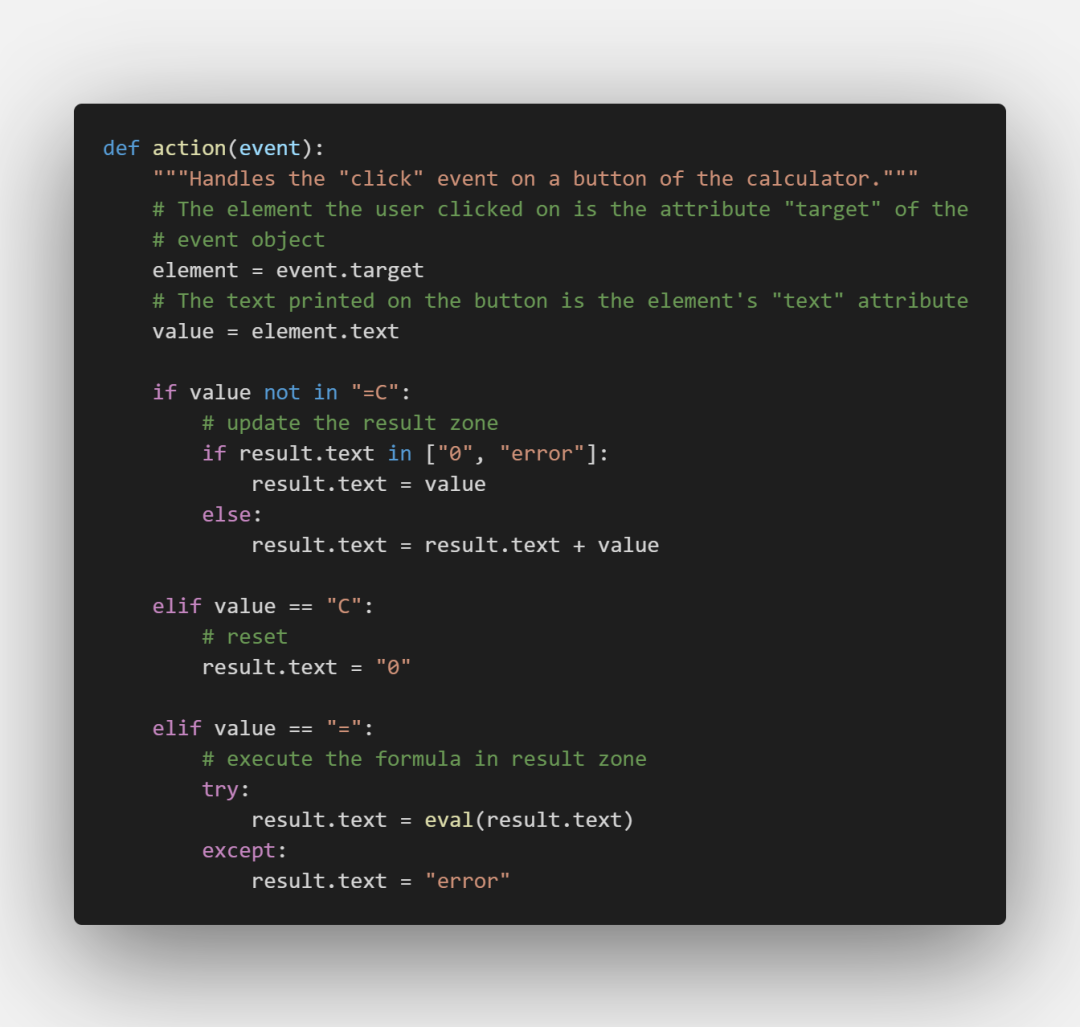Python作为胶水语言,真的是无所不能。这不,最近又出现一个基于Python3,目标是替代JavaScript的前端开发工具—Brython.
好用吗?咱今天来试试用它写一个计算器有多简单:
不过,我们首先要知道它作为Python的客户端Web编程工具,和JS有什么区别呢?
1.特点
1.可轻易地在页面中内嵌Python终端进行测试

2.运行速度接近于CPyhon
3.写法方便,社区强大,可进行敏捷开发
我个人觉得相同的功能,用Python写起来可能会比JS快。
4.和JS一样,你不用安装任何东西就可以开始编写
下面就用Brython做一些简单的实验吧。
2.实验
1.在页面上显示 Hello !:
< !doctype html >
< html >
< head >
< meta charset="utf-8" >
< script type="text/javascript"
src="https://cdn.jsdelivr.net/npm/brython@3.8.9/brython.min.js" >
< /script >
< /head >
< body onload="brython()" >
< script type="text/python" >
from browser import document
document <= "Hello !"
< /script >
< /body >
< /html >
将这份代码保存为index.html,双击在浏览器中打开,即可看到Hello !字样:

原理:
代码的head中,引入了一个Brython引擎附带的 brython.min.js 模块,用于使用Python控制页面。
而在 和 之间就是相应的Python代码。
可以看到,需要在document中显示文本,直接输入:
document <= "你所需要显示的文本"
即可,后续你将会看到用Brython使用标准化的DOM语法和页面交互的例子。
2.用HTML标签来做文本格式化:
如加粗文本:
from browser import document, html
document <= html.B("Hello !")
部分加粗、部分不加粗:
from browser import document, html
document <= html.B("Hello, ") + "world !"
i 标签:
document <= html.UL(html.LI(i) for i in range(5))
超链接:
document <= html.A("Python实用宝典", href="https://pythondict.com")
以上例子如下:
< !doctype html >
< html >
< head >
< meta charset="utf-8" >
< script type="text/javascript"
src="https://cdn.jsdelivr.net/npm/brython@3.8.9/brython.min.js" >
< /script >
< /head >
< body onload="brython()" >
< script type="text/python" >
from browser import document, html
document <= html.B("Hello !")
document <= html.UL(html.LI(i) for i in range(5))
document <= html.A("Python实用宝典", href="https://pythondict.com")
< /script >
< /body >
< /html >
效果:

3.写一个简单的计算器
先写好简单的图形架构,用th和tr标签即可:
from browser import document, html
calc = html.TABLE()
calc <= html.TR(html.TH(html.DIV("0", id="result"), colspan=3) +
html.TH("C", id="clear"))
lines = ["789/",
"456*",
"123-",
"0.=+"]
calc <= (html.TR(html.TD(x) for x in line) for line in lines)
document <= calc
图片版代码:


然后加上一些css就可以把这个简单的图形架构变漂亮了:
< style >
*{
font-family: sans-serif;
font-weight: normal;
font-size: 1.1em;
}
td{
background-color: #ccc;
padding: 10px 30px 10px 30px;
border-radius: 0.2em;
text-align: center;
cursor: default;
}
#result{
border-color: #000;
border-width: 1px;
border-style: solid;
padding: 10px 30px 10px 30px;
text-align: right;
}
< /style >

最后只需要做运算符的事件触发器即可,从下面这行代码:
calc <= (html.TR(html.TD(x) for x in line) for line in lines)
可以看出,所有的按钮都被创建为td标签,因此我们要获得所有这些按钮是否被点击,仅需要:
for button in document.select("td"):
button.bind("click", action)
意思是,按钮被点击后便执行 action 操作,action操作定义如下:
def action(event):
"""Handles the "click" event on a button of the calculator."""
# The element the user clicked on is the attribute "target" of the
# event object
element = event.target
# The text printed on the button is the element's "text" attribute
value = element.text
if value not in "=C":
# update the result zone
if result.text in ["0", "error"]:
result.text = value
else:
result.text = result.text + value
elif value == "C":
# reset
result.text = "0"
elif value == "=":
# execute the formula in result zone
try:
result.text = eval(result.text)
except:
result.text = "error"
图片版代码:

如果不是=号或C号,则进行 字符串拼接 。
如果是C号,则清空result。
如果是=号,则需要计算出结果,直接对字符串用eval()函数即可完成目的。
这边是全部核心代码了,写起来真的极其方便。
-
Web
+关注
关注
2文章
1272浏览量
69817 -
计算器
+关注
关注
16文章
438浏览量
37510 -
javascript
+关注
关注
0文章
525浏览量
54018 -
前端开发
+关注
关注
0文章
26浏览量
4511
发布评论请先 登录
相关推荐

可视化的javascript开发工具
Chrome引发WEB开发工具之战,Javascript,
ARM开发工具解读

web前端开发工具排行:8款html开发工具推荐下载
如何使用KEELOQ3开发工具包作为开发工具来在目标板上仿真和调试固件





 Brython:替代JavaScript的前端开发工具
Brython:替代JavaScript的前端开发工具












评论